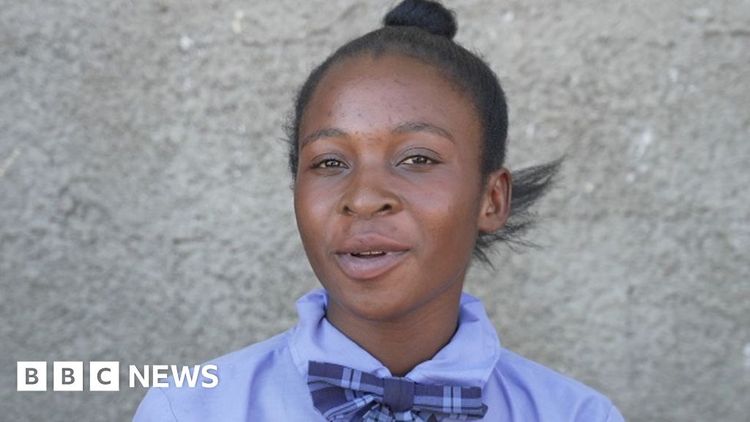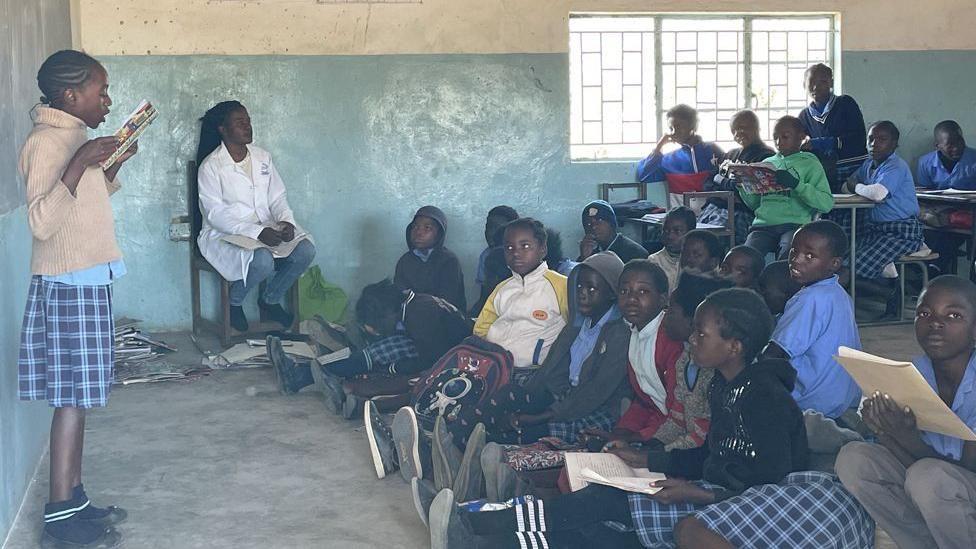Zambia education: Schooling was made free, now classrooms are crammed

At 7:00 in the morning on a cold winter day, a bunch of students have just reached Chanyanya Primary and Secondary School, which is located just a bit more than an hour's drive to the southwest of Zambia's main city, Lusaka.

16-year-old student, Richard Banda, advises arriving at school early due to a lack of desks. He recalls a time when he arrived late and had to sit on the cold floor because there were no seats available.
His unease highlights the issue of insufficient resources and overcrowding caused by providing free education for elementary and high school students here.
The school is located in a compound with 10 classrooms arranged in a horseshoe formation around a playground. The playground is filled with acacia trees and plants growing in the sandy soil.
The morning sunbeams are shining through the dust clouds kicked up by children sweeping the classrooms.
Right before the bell sounds, a student quickly runs to the center of the playground and proudly hoists the flag of Zambia up a high pole.
The morning routines have become a regular part of the day for an additional two million children who have been able to attend public schools for free since 2021, thanks to the government's decision to make education accessible to all.
However, experts warn that the lack of sufficient infrastructure investment is now putting the quality of education at risk, particularly for students from low-income backgrounds.
Mariana Chirwa wouldn't be able to attend school if she had to make payments.
"In 2016, when I was in grade four, I decided to stop attending school," shared 18-year-old Mariana Chirwa, wearing the Chanyanya's girls uniform of a light-blue shirt with a tartan bow.
If education wasn't free, I don't know how my parents would have been able to afford to send me back to school. They don't have jobs and are just at home.
In the headteacher's office at Chanyanya school, there is a poster showing the sizes of classes. This poster highlights the difficulties that schools like Chanyanya have to deal with.
In a classroom, there are 75 boys and 85 girls packed into a space that is only meant for 30 students.
"When I began teaching in 2019, I had approximately 40 students. Now, I have over 100 students in just one class," shared Cleopatra Zulu, a 33-year-old teacher.
Every day we welcome new students who are benefiting from our tuition-free program. Providing individual attention is a challenge, as well as grading their work. We have also decreased the amount of subjects we offer to them.
Richard Banda believes that as the number of students increases, teachers may not be able to provide individual attention to each student.
The story of student Richard Banda illustrates this point.
"We learn differently now compared to when we had to pay, there's a slight variation," he explains to the BBC.
In the past, when there were only a few of us, the teacher would go over a topic a second time if we didn't understand. But now that there are more students, the teacher doesn't review the material again. That's the change we've noticed.
Unicef reports that there is a rise in the amount of students in sub-Saharan Africa. More children are attending school now than in previous years.
However, Unicef reports that 90% of primary school students in the area are still having difficulty reading and comprehending basic texts. As a result, policymakers are now prioritizing the quality of education, the recruitment of skilled teachers, and the provision of proper facilities and resources.
"When you don't sit correctly in a classroom, it can impact how well you focus on the lesson and how effectively you take notes," explains Aaron Chansa, who leads the National Action of Quality Education in Zambia (NAQEZ), a group that advises the government.
"We are noticing students entering secondary school without proper reading skills," he reports, noting that this issue is widespread nationwide.
In the Eastern Province, there are over 100 students in a single classroom, leading to a high book-to-pupil ratio. Sometimes, one book is shared among six or seven students, causing competition and difficulties for all learners.
The government claims they are actively listening and implementing measures to tackle the issues caused by providing education at no cost.
Education Minister Douglas Syakalima believes that having crowded classrooms is a preferable issue over children being out on the streets. He sees it as a positive problem to have.
The president has started making a lot of desks and is also working on building lots of new infrastructure.
Education has the power to transform lives, but it must be adequately funded.
Zambia has put more than $1 billion into the education system since they started offering free education three years ago. This investment was crucial as spending on education had been decreasing in relation to the country's GDP for several years.
The government has declared intentions to construct more than 170 brand new schools and has promised to bring on board 55,000 fresh teachers by the conclusion of 2026, with 37,000 already on board.
The relocation has created new job options, however, it has caused a lack of housing in remote areas. Some educators are stating they must reside in houses with thatched roofs and use shared pit toilets that may overflow.
"In the rainy season, it's not the best time to come visit us," shares Ms. Zulu, a resident of the school campus who was anxious about the threat of cholera during the recent outbreak.
Outside of her home, there is a big dried up puddle of shower gel that shows where someone bathed outside in the darkness before the sun rose, without any privacy.
"The homes we reside in are practically dangerous," Ms. Zulu expresses. "It's crucial for the government to take action regarding the housing situation, particularly focusing on the sanitation facilities."
Cleopatra Zulu is now educating over double the number of students she taught a couple of years ago.
Concerned about what their children are learning, a few families have started to make changes on their own.
Robert Mwape works as a taxi driver in the city of Lusaka.
In 2022, he transferred his 11-year-old son from a school that required fees to a school that is funded by the government in order to save money on education costs. However, he quickly realized that this decision was not the best choice.
I saw that my son's grades were dropping, so I decided to visit his classroom one day. It was crowded with students chatting and distracting the teacher, making it difficult for the teacher to keep the class focused.
The next year, Mr. Mwape, who preferred to remain anonymous, changed his mind. His son, who is now 13 years old, has returned to a private school.
As Zambia continues to recover from a debt default in 2020, there are concerns among some experts about the long-term viability of the free education program.
A report released in 2023 by the Zambia Institute for Policy Analysis and Research suggests that if every student who is eligible for free education takes advantage of the opportunity, government spending is expected to double. This raises concerns about whether future governments will be willing to sustain this policy.
However, the education minister expressed assurance that the government can handle the expenses.
According to Mr. Syakalima, education is the most effective economic strategy. He believes that there is no challenge in this perspective.
Many believe that offering free education is an important initial move in providing opportunities for young Zambians to have a better future.
However, the nation's current situation demonstrates the difficulties of handling an increasing student population while also striving to uphold the standard of education they are provided with.
Explore More: 10 Recommended Reads
Picture credit, Getty Images/BBC.
Visit BBCAfrica.com for further updates on the latest happenings across the African continent.
Connect with us on Twitter @BBCAfrica, on Facebook at BBC Africa, or on Instagram at bbcafrica.









































